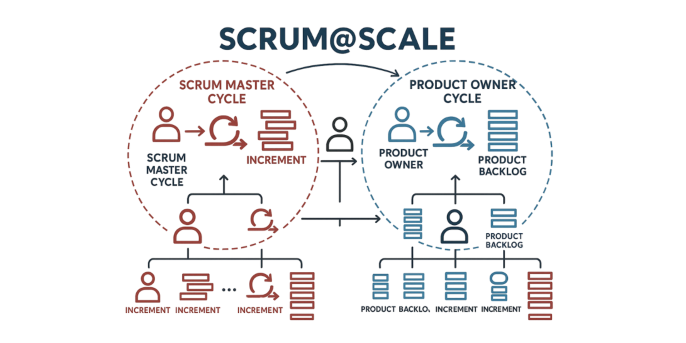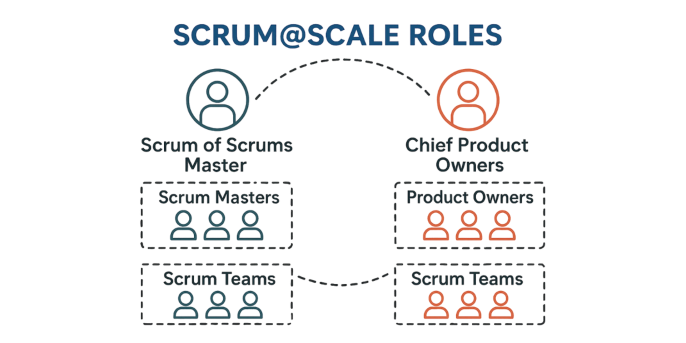23. abril 2025 por Silvia Pelegri
Why Scrum@Scale? The Minimalist Approach to Scaling Agile
Scrum@Scale is an adaptable and modular framework that builds upon the foundational principles of Scrum to facilitate its implementation across multiple teams and large organizations. Created by Dr. Jeff Sutherland, who co-founded Scrum, this framework specifically targets the complexities associated with scaling Agile methodologies effectively.
Scrum@Scale addresses common challenges such as bottlenecks that can impede progress, excessive overhead that can waste resources, and the need to preserve the inherent flexibility that makes Scrum so impactful. By utilizing clear roles, responsibilities, and a structured approach to coordination, Scrum@Scale enables organizations to synchronize their efforts across diverse teams while fostering improved communication and collaboration. This ultimately enhances productivity and agility, allowing enterprises to respond swiftly to changing market demands and customer needs.

In contrast to traditional scaling frameworks that often enforce rigid hierarchies and bureaucratic structures, Scrum@Scale presents a more flexible and adaptive approach. It emphasizes:
✅ Minimal Viable Bureaucracy (MVB)
- This principle focuses on implementing only the essential processes necessary for effective work coordination, ensuring that teams can operate efficiently without unnecessary red tape.
✅ Decentralized Decision-Making
- By empowering teams with the authority to make decisions, Scrum@Scale fosters an environment where agility thrives, eliminating the constraints of top-down control and allowing for quicker responses to changes.
✅ Seamless Scaling
- This approach accommodates growth effortlessly, whether it's scaling from a handful of teams to thousands, all while maintaining and upholding Scrum's fundamental values. This ensures that the core essence of collaboration and transparency remains intact, regardless of the scale.

Team-Level Scrum: In this structure, each individual team operates within the framework of standard Scrum roles, which consist of the Product Owner (PO), Scrum Master, and Developers. The teams engage in crucial events such as Sprints, where they deliver increments of work, Daily Standups for quick coordination and alignment, and Retrospectives that focus on continuous improvement and reflection.
Scrum of Scrums (SoS): This innovative approach facilitates effective cross-team coordination through a meta-Scrum framework. By bringing together representatives from different teams, the Scrum of Scrums ensures that teams remain aligned on critical dependencies and overarching priorities, fostering a collaborative environment that enhances overall productivity.
Scaled Roles:
Chief Product Owner (CPO):
The CPO plays a pivotal role in unifying the vision across various Product Owners. They strategically align the goals of multiple teams to ensure that everyone is working toward a cohesive organizational objective, thus maximizing the value delivered to stakeholders.
Scrum of Scrums Master (SoSM):
Acting as the connector among teams, the SoSM facilitates communication and collaboration across the Scrum of Scrums. This role is crucial for identifying bottlenecks and addressing inter-team challenges, thereby promoting a culture of synchronization and mutual support.
Executive Action Team (EAT):
Comprising senior leadership, the EAT is dedicated to addressing and removing organizational impediments that hinder progress at scale. This proactive group empowers teams by eliminating barriers, ensuring that they can operate efficiently and effectively in their pursuit of project goals.
When to use Scrum@Scale?
?? If you're looking for scalability without the hassle of heavy processes.
?? If your leadership supports empowered, cross-functional teams.
?? If you want to keep Scrum’s simplicity while you grow and evolve.
Challenges to Consider:
✅It necessitates a robust level of Scrum maturity within the team, meaning that teams must be well-versed in the principles and practices of Scrum to effectively implement this framework.
✅Scrum@Scale is inherently less prescriptive than the SAFe (Scaled Agile Framework), which means organizations may have to tailor its application to fit their specific internal processes and culture.
Final Take:
Scrum@Scale emerges as the optimal framework for organizations intent on scaling Agile methodologies while steering clear of bureaucratic entanglements. By prioritizing the formation of interconnected networks of Scrum teams over conventional top-down control structures, this approach fosters an environment where enterprises can remain agile, responsive, and unwaveringly focused on meeting customer needs.

